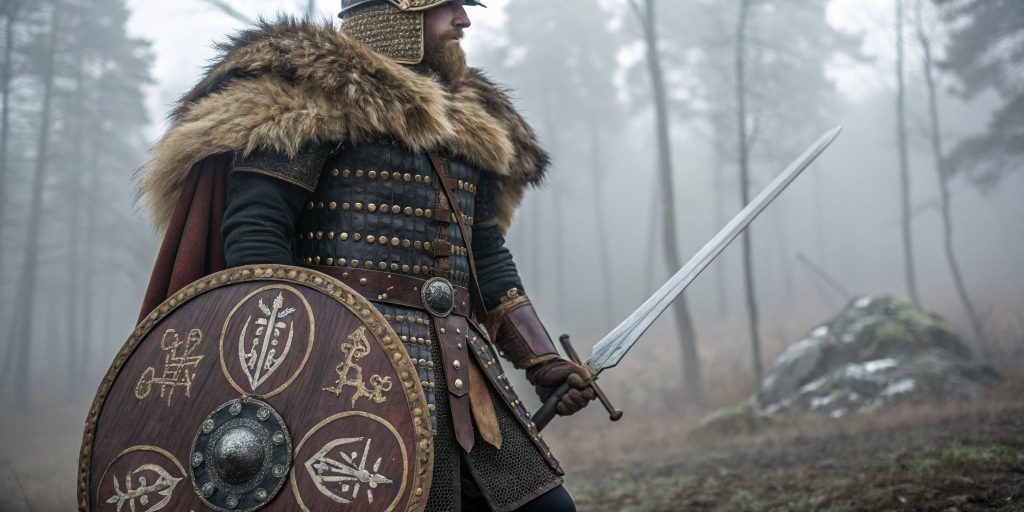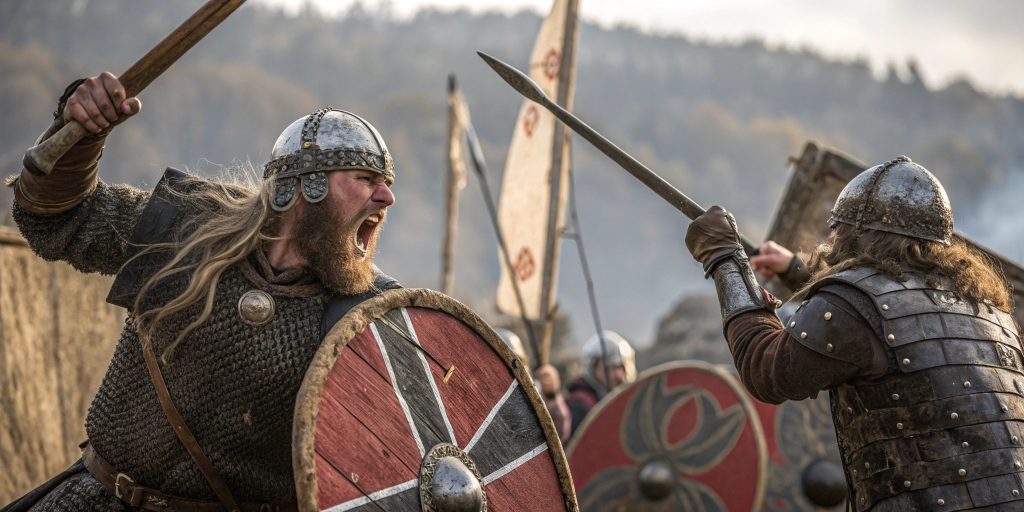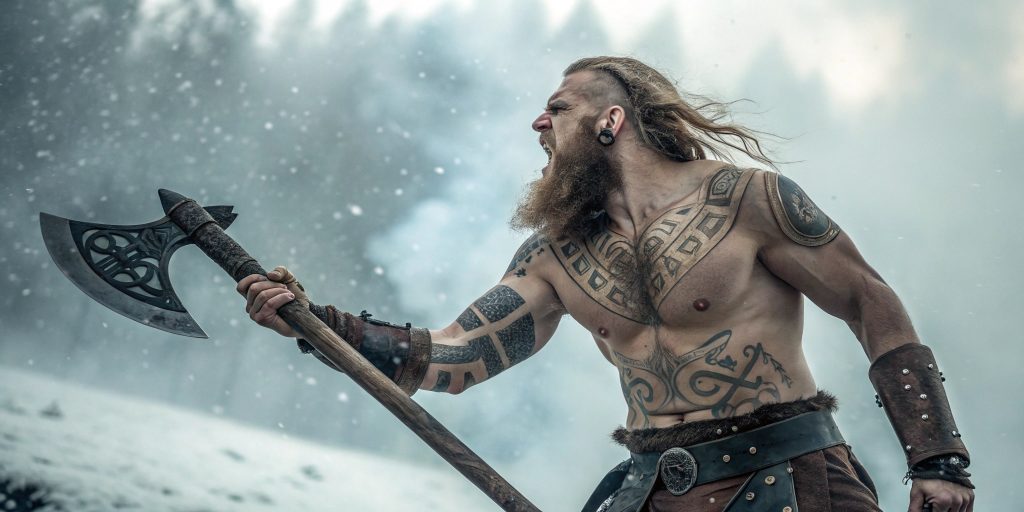Berserkers and Other Shamanic Warriors, Viking Weapons and Armor, Vikings
Did Vikings Fight Bare Chested?
The image of a shirtless Viking in battle has caught many imagination. It creates a stereotype that still exists today. This idea makes us think Vikings fought without armor, showing off their strength.
But is this image actual, or is it just a product of modern interpretations? Let’s explore the origins of this myth, searching through historical texts and contemporary interpretations to understand its evolution. We’ll look at historical fantasy and the Viking military culture, trying to separate fact from fiction on this fascinating page of history. This will help us understand the truth behind the famous image.
The Iconic Image of the Shirtless Viking
The image of a shirtless Viking is well-known in today’s pop culture. It is often portrayed in pictures that emphasize their fierce reputation. This look shows the raw, rugged look of Viking warriors. It has captured many with its romantic charm, reminiscent of the brave pathfinder spirit of the Vikings.
The media has played a big part in making this image popular, often showcasing shirtless Viking stock photos that enhance their allure. This has fueled our interest in their fierce battle persona, making us want to shop for memorabilia that captures this essence.
Top Reasons for the Shirtless Depiction
There are a few reasons why Vikings are often shown without shirts:
- The appeal of strength and virility associated with a shirtless warrior.
- The dramatic aesthetic of Viking imagery enhances the visual storytelling.
- A romanticized view of Viking culture that prioritizes theatricality over historical accuracy.
How Pop Culture Influences Perception
Media has a big role in how we see Vikings, influencing our perception through movies, documentaries, and online video content. TV shows, movies, and games show them as fierce fighters. They highlight their primal nature:
- Key series and films contribute to the enduring appeal of the shirtless viking image.
- Merchandising featuring Viking themes helps perpetuate this iconic imagery, making products like shirtless Viking stock photos available for fans.
- Documentaries and dramas blur the lines between fact and fiction, further embedding this perception in popular culture.
These portrayals show what society finds interesting. They also changed how we see Viking history. The shirtless viking image is a mix of history, art, and pop culture.
Historical Evidence of Viking Combat Attire
The Viking Age is full of interesting facts about the clothes of Norse warriors. We learn about their clothing choices through archaeological finds and historical texts. These sources show us how Vikings dressed for battle, focusing on practicality and safety.

Archaeological Discoveries and Clothing
Many archaeological finds give us a peek into Viking war clothes. Burial sites and battlefields show us what they wore:
- Metal armor, which kept them safe from weapons
- Durable leather clothes, great for moving in battle
- Fur linings for warmth in cold weather
These findings show that Vikings chose strong and safe clothes, ensuring they could effectively follow their battle strategies. This is different from the image of shirtless warriors we often see.
Written Accounts and Documentation
Historical texts also help us understand Viking clothes. Authors like Saxo Grammaticus and Ibn Fadlan describe their clothing, explaining how Vikings chose clothes for protection, not just looks.
These texts highlight how important protection was to Vikings. They show that their clothes were made for safety, not just for looks, emphasizing the size and durability needed in combat.
The Role of Berserkers in Viking Warfare
Berserkers were key in Viking battles. They were seen as fierce and out of control, often depicted in videos that dramatize their legendary status. Their battle style was marked by fearlessness and frenzy, akin to a hot male warrior charging into combat. This has led to much debate about their fighting methods and whether stories have made them seem bigger than they were.
Understanding the Berserker Phenomenon
“Berserker” comes from Old Norse, meaning warriors who fought incredibly. They were thought to enter a trance before battle, becoming immune to pain and fear. This made them very effective in Viking battles, striking fear into their foes, as depicted in various media and video games.
Many stories tell of these warriors’ fierce and relentless natures, which were a big part of Viking military tactics.
Do Berserkers Typically Fight Shirtless?
Some stories say berserkers fought without armor, but it’s not simple; they often relied on their size and strength to intimidate enemies, much like a hot male warrior. Historical texts suggest some might have fought without shirts, but this might be an exaggeration. In real battles, the armor was crucial for survival.

Not wearing armor would have been a big disadvantage. This mystery makes us want to learn more about Viking combat and the legend of Berserkers, prompting us to search for more information.
Practical Considerations in Battle
Vikings are often seen as brave warriors. But, their battles were more about survival than bravery, as they usually had to contact allies for support. Armor and protection were key to their success.
The Importance of Armor and Protection
Armor was vital in battle. Vikings wore helmets, shields, and chain mail to stay safe. These items helped them fight better and live longer.
Weather Conditions in Nordic Regions
The cold Nordic climate was challenging for Viking warriors, who had to follow strict training regimens to prepare for battle. They needed warm clothes and gear to stay strong, and fighting in the cold without armor was not practical.
Final Words
Viking history shows a big difference between the romantic idea of shirtless Viking warriors and their real armor use. Myths about shirtless Vikings ignore the smart planning of these Norsemen. They chose armor for safety in fights.
Pop culture and stories make it seem exciting, but history tells a different story, one that we can explore on this page dedicated to Viking lore. Vikings were good at war and knew the value of wearing the right clothes designed to fit their combat needs. This shows they were more than just fighters.
The idea of shirtless Viking myths changes how we see Viking culture and fighting. Instead of just being solid fighters, history shows Vikings were smart and careful. This makes us think more about their society and challenges the stories we see in movies, urging a review of historical accuracy.
In short, the idea of shirtless Vikings might be interesting, but the truth is that they were smart and safe, much like a pathfinder navigating through challenges. By looking at these myths, we learn more about Viking history. This helps us appreciate their strength and how they faced challenges.

